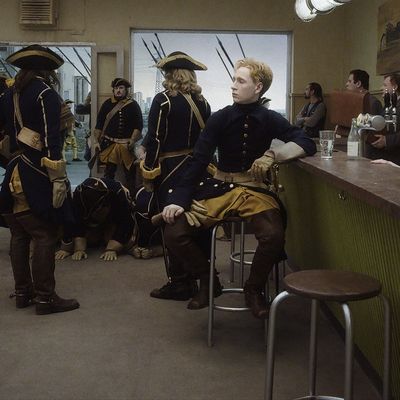
The Swedish director Roy Andersson makes what could be called cinematic dioramas. Shot in static, rigorously composed long takes, his oblique scenes depict mini-worlds that reflect all the absurdity, cruelty, and humor of our own but are still somehow other. His latest, A Pigeon Sat on a Branch Reflecting on Existence, which won the Golden Lion at Venice last year, is one of the weirdest films you will see this year. With its lengthy shots and odd longueurs, it may feel frustrating at first ÔÇö especially for those who havenÔÇÖt seen the directorÔÇÖs earlier films, like Songs From the Second Floor and You, the Living, with which this film forms a loose trilogy. But stick with it. On the page, AnderssonÔÇÖs approach may seem deadly and pretentious, but his expert timing, his eye for detail, his flair for the ridiculous, and his use of the chasmic possibilities of deep focus mark him as a genuinely cinematic talent ÔÇö the secret love-child of Jacques Tati, Monty Python, and Ingmar Bergman.
ThereÔÇÖs no way to accurately summarize the plot of Pigeon. Through a series of occasionally interconnected vignettes, we follow several characters, among them two sad, middle-aged men attempting to sell novelty items ÔÇö including vampire teeth, whoopee cushions, and something called an ÔÇ£Uncle One-ToothÔÇØ mask ÔÇö to a variety of random people. (ÔÇ£WeÔÇÖre in the entertainment business,ÔÇØ they say, without any change to the glum frowns on their faces.) ThereÔÇÖs also a dance instructor brazenly hitting on one of her students, an officer who has gotten the date of a military lecture wrong, and sad people drinking in bars. Lots of sad people drinking in bars.
In what might be the filmÔÇÖs most touching scene, a deaf old man sits by himself in one bar while a waitress tries to get his attention. We then flash back to the same place in 1943, a boisterous beer hall where the proprietress, a smiling, bold woman named Limping Lotta, sings a song and is joined by a group of young soldiers, whom she lets pay for their drinks with kisses. When the scene cuts back to the present, we see the older man being helped into his coat by the waitress and some other patrons ÔÇö a brief moment of humanity and community in this otherwise alienated world. Did he dream that flashback? Was he in it? Who knows? We were there, and suddenly this throwaway moment ÔÇö a man struggling with a coat ÔÇö gains breathtaking resonance.
A bar is central also to the filmÔÇÖs most bravura scene, which comes right smack-dab in the middle of the movie and features the absurd sight of a present-day bar being visited ÔÇö nay, invaded, by Charles XII, who ruled Sweden from 1682 to 1718. After having the women kicked out and a random guy flogged, the king orders a mineral water while hundreds of soldiers and horses march outside, singing along on their merry way to invade Russia. The king spies a young male bartender, then tries to quietly seduce him. (ÔÇ£His majesty the king thinks a man as young and as handsome belongs on the battlefield. He can sleep in the kingÔÇÖs tent.ÔÇØ) The scene is Pythonesque in its surrealism, and yet thereÔÇÖs a grave intensity to it, too ÔÇö we sense, briefly, the power of the kingÔÇÖs station, and what itÔÇÖs like to be wooed by a monarch. ItÔÇÖs a fleeting power, though: Later, we see the same bar as the king returns, half-dead, from his defeat at the hands of Peter the Great. This time the women, all war widows, remain in their seats. Unable to stand, all the king wants to do is use the bathroom; but, well, itÔÇÖs occupied.
History is ever-present in Pigeon. The grim, grey present contrasts starkly with the majesty of the past throughout the film. But that majesty is an illusion, because the past is also a place of horror. In one unbearably ghastly scene late in the film, we see a colonial army forcing Africans into a giant, unfamiliar apparatus whose purpose slowly becomes terrifyingly clear. Life, in AnderssonÔÇÖs world, seems to be an eternal trade-off between the mundane and the monstrous.
But IÔÇÖm getting carried away here, trying to interpret something thatÔÇÖs not meant to be interpreted ÔÇö just experienced. Andersson doesnÔÇÖt seem to be interested in grand theses. He presents these immaculately conceived dream-visions to us, in the hope that something in there might reflect back on our own lives. ThatÔÇÖs why, beneath all that surrealism and all those impressively staged fantasies, I think he remains a humanist. He punctuates his film with occasional shots of children playing with bubbles or performing in talent shows, or a mother making her baby laugh, or a young couple making out in the park. And even those two sad little men trying to sell novelty items with perpetual glowers on their faces turn out to have surprising depths. For all the despair and horror on display in A Pigeon Sat on a Branch Reflecting on Existence, you walk out of it as if on a cloud, light and hopeful.


